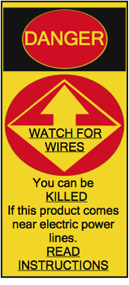*Specifications subject to change.
All trademarks are the trademarks and/or service marks of their respective owners.
Non-Conductive Antenna Pulleys



Before mounting any antenna system you need to consider every possible danger. Power lines and lightning are among the chief concerns but falls and antenna items falling on installers need to be watched out for. There’s also RF Exposure, follow the FCC OET Bulletin 65 and Amateur Radio Supplement B to OET Bulletin 65 guidelines.
When surveying the area where the antenna is to be mounted use a worst case scenario approach rather than a not likely to happen approach. Look up and around in all directions of where you plan to install the antenna and it’s support items(masts, pipes, guy lines etc.) Installing an antenna above or below a power line is extremely dangerous. But also take into consideration how far a wind thrown or whipped portion of the antenna system can travel and make contact with a power line. And also consider how far a broken piece of power line can be thrown or whipped from the poles they are mounted on.
Even if your antenna is insulated in a material like PE, PVC, or Fiberglass does NOT mean it can sustain those insulation properties when faced with power line voltages. There is also the matter of insulator leakage where even a micro sized hole invisible to the eye provides a path through the insulation. In some instances power line voltages are high enough that direct contact is not needed, simply being near enough will cause an arc over that is deadly. There are online videos of Hot Air Balloons that come in contact with power lines and they are not pleasant to see.
So ask yourself before proceeding. “If any part of my antenna system or the power lines fail can they come in contact or near when driven by the wind?” Likewise don’t try to install antennas in bad weather conditions.
